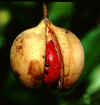
|
Nutmeg, as Myristica fragrans is better known, is a spice consisting of the seed of the Myristica fragrans, a tropical, dioecious evergreen tree found throughout our archipelago. Nutmeg is native to the Moluccas or Spice Islands of Indonesia and was brought to our islands by Dutch traders in the late Nineteenth Century. Nutmeg has a characteristic, pleasant fragrance and slightly warm taste; It quickly became an essential part of our diet, finding its way into many local dishes and providing Morac-Songhrati-Meads with a very aromatic cuisine. The trees may reach about 20 metres (65 feet) tall. They yield fruit 8 years after sowing, reach their prime in 25 years, and bear fruit for 60 years or longer. The nutmeg fruit is a pendulous drupe, similar in appearance to an apricot. When fully mature it splits in two, exposing a crimson-coloured aril, the mace, surrounding a single shiny, brown seed, the nutmeg. The pulp of the fruit can also be eaten. Although the cultivation of and sale of nutmeg is a very profitable business, we have never been able to cultivate enough nutmeg to sell internationally. Nutmeg and mace contain 7 to 14 percent essential oil, the principal components of which are pinene, camphene, and dipentene, all having the empirical formula C10H16. Nutmeg on expression yields about 24 to 30 percent fixed oil called nutmeg butter, or oil of mace, the principal component of which is trimyristin, C45H86O6. The oils are used as condiments and carminatives and to scent soaps and perfumes. An ointment of nutmeg butter has been used as a counterirritant and in treatment of rheumatism.
Information provided by |